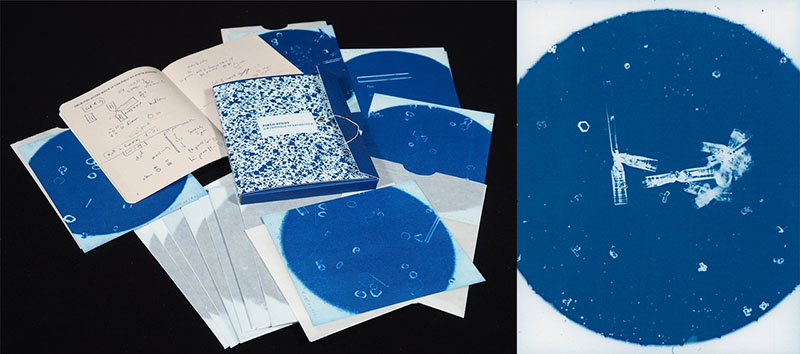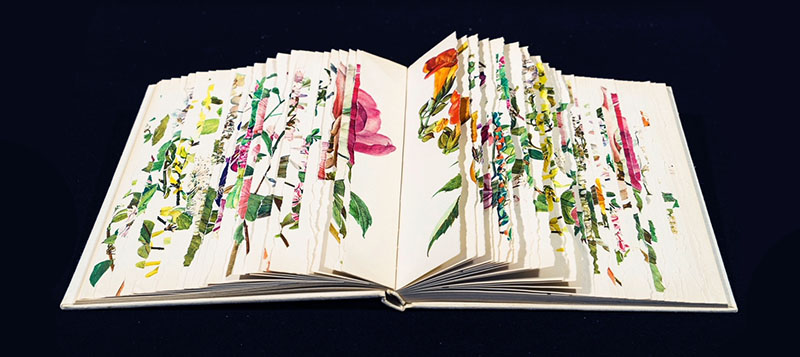Modern Codex

This nontraditional artist book was inspired by the research of Steve Warren and Von Walden who photographed ice crystals in Antarctica through a microscope over a three-month period in the early 1990s. I was immediately fascinated by the beauty and mystery of these source images and, with the scientists' permission, endeavored to translate selected images into cyanotypes. I chose this medium because of its ephemeral nature, which seemed in keeping with the depiction of such fleeting elements as ice crystals. Working with scientific source material and mathematical equations as inspiration has been something that I have pursued for a number of years.
Field Study consists of 14 double-sided folios contained in handmade glassine sleeves (a reference to how laboratory slides were stored) and a "composition" book that contains both my commentary and field notes of the scientists, along with an abstract describing the study.

Using the fractal forms of nature as building blocks, the photographs in Source Code are derived from the idea that the alphabet is the source code for communication in all Romance languages. Individual letters are combined and recombined to form language. Replicated over and over in nature to form a larger whole, fractals function similarly in nature. In the computer world, source codes like Fortran set the rules for the computer so it can be translated into machine language, often combining strings of 1s and 0s. By and large, computer language remains a mystery to all but those trained in this obscure code. In contrast, the written alphabet is accessible by all who can read. Though Romance languages can be a barrier to non-native and untrained speakers, the building blocks are shared.
During a residency at Brush Creek Foundation for the Arts, I came across a slash pile of branches, cut wood and leaves and saw the potential to transform it into a book that would include all 26 letters of the alphabet. Each letter was arranged and photographed in situ.

By tearing down each page and rearranging them, I am calling to mind the experience of viewing a garden in full bloom where rather than experiencing one plant at a time, the viewer experiences the richness of the combination of flora. The original book was acquired in an antiquarian bookshop located along the Sâone River in Lyon, France. The illustrations are by Jirina Kaplická.

The Book of Small Regrets was conceived in response to the forced isolation of COVID when even small missteps could seem catastrophic. As an antidote, I decided to create this artist book to help vanquish these little black clouds that immediately overwhelm, then linger and fade, only to be replaced by another when one least expects it.
Like getting over anything, admitting your regrets is the first step to recovery. Naturally, I wanted others to be able to be rid of theirs too. So, I reached out through my social network to over 300 people, asking them to contribute their own small regrets (to be presented anonymously) as a way to "unburden themselves" as part of the generative process of making the work. Later I solicited impulse purchases made and comfort foods eaten during the pandemic. The responses served as prompts for my watercolor paintings, photographs and text, embracing irony, humor and generosity.
The final section of the book suggests a "scientific analysis" of regrets as a way through them, concluding with William Bruce Cameron's quote "not everything that can be counted counts, and not everything that counts can be counted."
Neither a literary work nor a graphic novel, it is a sequential visual experience, creating an empathetic and heartfelt journey through these small difficulties we all encounter.

As I watched our democracy under attack from within, I believed it was necessary to take every action that I could as an artist to foster and protect our democracy. I wanted to ring the "5-alarm fire bell." Inspired by Timothy Snyder's On Tyranny and The Road to Unfreedom, I began The Autocrat's Playbook in early spring 2018 and arranged for delivery to my target audience's hands prior to the November 2018 mid-term Congressional election.
The Autocrat's Playbook concisely describes the steps autocrats traditionally take to achieve their dictatorial aims. It was a call to action in response to the very real jeopardy that the U.S. democracy faced under the Trump administration. The pocket-sized pamphlet references both a coach's football playbook and a pocket Constitution. The Autocrat's Playing Card tucked in the back references both the Joker in a common deck of cards as well as the collecting of both football and baseball cards.
Each book was accompanied by a personal letter, explaining why each person was selected to receive it, along with a list of other recipients.
Following the tradition of the Mail Art movement of the 1960s and 70s, I elected to take control of getting the art to my intended audience, rather than waiting or hoping for the audience to come to the art. I relied on friends-of-friends and the U.S. Postal Service for the completion of delivery. I received personal responses by letter or email from nearly one-third of the recipients.
The work was exhibited at Atlas Arts in Seattle in November 2018 as the mid-term elections unfolded. Democrats retook the majority in the U.S. House of Representatives. The threat to our democracy continues today.

In State of the Nation, all the states in the union featured in the atlas are torn and rearranged to call attention to the fractured state of the nation. Black and white photographs of particular sites, previously in the index, have been collaged into the body of the book. It is a call-to-action to knit our country together.
Artist Statement
As an American Jew, my work is informed by the traditional concept of "tikkun olam" that roughly translates "to heal the world." In practice, this means I view my art as a way to marry my passion for visual expression with my commitment to helping build a more just society. My work often involves engaging with community and this informs the artistic process and product. It is project-driven, multilayered and embedded in research.
My work conceptually follows several threads: political/social engagement; mining the intersection of art, science and nature; exploring moral/ethical dilemmas. The forms, methods and materials are varied in response to these ideas and in relation to how the art will be experienced. I create site-specific permanent and temporary installations, social action projects, photo-based works and artist books.
My studio work weaves the personal with the political, while much of my public works and temporary installations are deeply grounded in "place." My interest in science has led me to collaborations with atmospheric scientists, aeronautical engineers and biologists. As an artist activist, I have undertaken a number of projects that involve reaching my audience directly through the mail or finding personal deliverers. I take inspiration from Lewis Hyde's writings about art being experienced as a gift rather than a commodity.

Ellen holds a BA in art history from the University of NC at Chapel Hill and a MA in urban studies from the University of Maryland. She is represented in museum and university collections, including Yale University Beinecke Library, NYPL Spencer Collection of Prints and Drawings, University of Washington Suzallo Library Special Collections, Vassar College, University of Puget Sound Collins Library, University of Delaware, Bainbridge Island Museum of Art, Seattle Art Museum Dorothy Bullitt Library, the Museum of NW Art and the National Museum of Women in the Arts. Her work has been included in exhibitions across the country, including the Museum of Northwest Art, Bellevue Arts Museum, Museum of Outdoor Art, Jack Straw Cultural Center, New York Center for Photographic Arts, New York Center for the Book and the Southeast Center for Photography. She lives in Seattle, Washington.